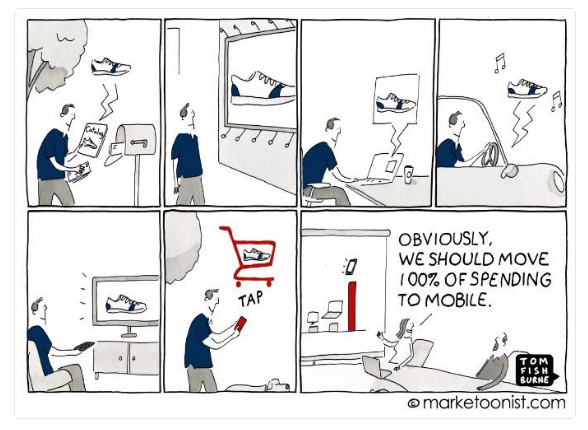With smartphones, computers, and TVs, there are always multiple screens within reach of consumers, which has led to an explosion of marketing channels and, with it, metrics and analytics to quantify and analyze customers’ interactions with brands.
However, when using analytics in marketing, you can easily get lost in the numbers, – and tools. This can lead to improper data interpretation, a failure of data integration and the creation of data silos or data cut off from relevant information flows, that can ultimately knock you off the path to your marketing goals.
So, what are some baseline tactics you can do to master the ever-growing world of marketing analytics?
Let’s take a look at how to use analytics to inform which channels and what content to optimize for the next stages of your marketing campaign.
Using Marketing Analytics for Identifying Opportunities
An Illustration From the Life Sciences
You have the equipment to run experiments researchers need. How can you connect your capabilities to a researcher’s challenges or pain points?
To give color to the challenge, imagine that you are a researcher in a lab and your equipment is outdated. You need and want the latest technology, but expensive instrumentation and equipment is not in the budget.
Now imagine you are a marketer at a contract research organization (CRO). You have the tools and equipment to run the experiments the researcher needs. How can you connect your capabilities to the researcher’s challenges or pain points?
Well, you can’t get inside their head. Or can you? By gathering information on your ideal customer’s buying behavior, you’re better able to predict their needs and the process they go through to get those needs met. Understanding this customer buying behavior is key for marketers, because there are many different routes your target customer may go through in search of a solution to their problem. They might browse the internet, ask colleagues for advice, browse catalogues, or even attend an event to find vendors. As a marketer, you must take note of all these potential channels.
Next, you need to consider that your ideal customers are also the same ideal customer targets for your direct competitors, other CROs in this example, as well as for a wide range of other companies vying for the customer’s limited capital. Think software companies, lab equipment manufacturers, pharma companies, and so on. In this environment, there are a few key questions for you to answer:
How can you improve your ability to market directly to people who are only browsing for solutions – versus those who already know they want the services of a CRO? How can you better analyze their customer buying behavior?
There are various ways of gaining customer data to understand their buying behavior, including direct feedback, analyzing web traffic, looking at competitors and evaluating your current marketing methods. (We covered one of these tactics in great detail using neuromarketing. Watch our webinar on-demand.) The goal is to gather these metrics in order to drill down into who your customers really are, the process they go through before picking a CRO, and what differentiates you from everyone else vying for their business.
Targeting customer buying behavior, motivations and actions requires data points. Data points turn into opportunities. And how do you find those opportunities? An effective way to understand customer buying behavior is called marketing attribution.
Understanding Customer Buying Behavior Using Marketing Attribution
Marketing attribution is a process that provides insight into customer buying behavior, enabling you to step back from the vastness of “your customers” and figure out what particular touchpoints impact your customer’s actions, assigning values to each point of contact. These touchpoints give insight into which channels and methods lead to a conversion. For our CRO, marketing attribution can help identify when, how and where conversion takes place and how to use that information to improve results.
Marketers need to know which campaigns and lead generation methods can directly correlate with conversions. But there are many attribution models that help to define this, each with pros and cons.
Below are three of the more common marketing attribution models designed to give you strategic insight into your buyers’ motivations and behaviors so that you can improve your odds for serving the right message to the right audience – at the right time.
#1: First-Touch Attribution
First-touch attribution essentially means the first point of contact is attributed to the result, giving 100% of the credit to marketing for an action taken by the customer.
A first-touch attribution effort is limited since it can only measure effectiveness for a single touch, the first one, which likely took place via a single channel for a single buyer stage, usually called the “top of funnel” stage. If you imagine the sales cycle as an inverted pyramid, the largest part of the funnel is the awareness stage where you have the largest number of customer targets. You just want people to know about you, who you are and what your products are.
For example, imagine the lab whose researchers are losing a lot of data due to compromised cell integrity during transfer. Maybe the cells keep dying when they are transferred between containers, or perhaps everyone uses a different process. Now imagine that you are a marketer for a CRO with expertise in managing biological materials. You might publish a blog post called “How to ensure cell integrity during transfer.” You decide to create a few pay-per-click (PPC) ads to come up when someone is searching for related topics.
When the head of the lab searches for “cell integrity and cell transfer,” on Google, your ad comes up, they click and suddenly they’re on your site. In this example, the first-touch attribution is given to the PPC ad, because it brought the researcher into the CRO’s website, which was the goal.
Why use this model? First-touch attribution is useful to find the best channels to first connect with a lead and is typically used early on in a marketing campaign. Your first-touch attribution will still assign value to conversions, interactions or traffic from content, forms, social media posts, paid search ads or whatever tactic you used to create awareness.
Look for this traffic under the Acquisition tab in Google Analytics, for example.
#2: Last-Touch Attribution
Last-touch marketing attribution is at the tail-end of first-touch attribution and refers to the marketing initiatives that customers interacted with last that led to a conversion. The logic here is that if a specific tactic is working to get conversions, you will want to know exactly which interaction put customers over the threshold to turn them from prospective customer to lead.
If your customer contacted you after a LinkedIn social media post or responded to an e-mail campaign, these last-touch efforts were most likely directed to customers who were further along in the buyer journey, having interacted with your brand several to many times before converting.

To use our CRO example, a last-touch attribution may be downloading a guide to ensure cell sample integrity.
That download was the very last action the customer took before conversion (entering their email to get the download), but there may have been a series of interactions that took place before that last-touch, such as a social media post, a retargeted ad placement, a video about cell sample integrity, branding your company at an industry event, or an email native ad placement for your services, and on.
Knowing what initiative led to this conversion can provide insight about the final thing that drove your customer to purchase, but it can also be deceptive since it doesn’t take into account all of the other touchpoints that led them there, – which is likely just as important.
#3: Multi-Touch Attribution
Multi-touch attribution is a solid strategy that looks at every single touchpoint on a customer’s journey from first- to last-touch. Converting customers requires nurturing trust through different levels of exposure from varied marketing initiatives. (It’s pretty rare to have a single-touch conversion, though possible.)
But more often, it’s the series of many marketing touchpoints measured by multi-touch attribution that is far more representative of most buyer behavior. Assigning multi-touch marketing attribution is more complex than first- and last-touch attribution because of all the different touchpoints a customer may go through toward their journey to a conversion. This is when being very targeted in your efforts, and segmenting your marketing campaigns, is most beneficial.
For our example CRO, having a PPC ad for a webpage highlighting a single service would be an example. Perhaps they clicked on a PPC ad for a blog post, then browsed other topics on your blog, which drew them into a capabilities page on your website. Later they see a native ad in their industry news email and clicked on it into a brochure. On the brochure’s last page was a link to a “contact us” form. That may have felt like a long sentence, but the point is that every step along the buyer journey, from the initial PPC ad to the “contact us” form, was important in understanding buying behavior.
Choosing the Right Marketing Attribution Model to Track Your Customer Buying Behavior
Marketing analytics and marketing attribution should be used hand-in-hand to analyze and direct your marketing strategy. Marketing analytics provides you with information about what your customers want and how they behave when looking for solutions to their needs, and marketing attribution helps you figure out which channels and tactics are most effective in converting your customers once you know who they are.
Using marketing analytics, you can view the channels that draw in your customers, the keywords they used to get to your webpages, the web pages they enter and leave from, and how long they stayed.
Quick Reference Types of Attribution Models List
The following marketing analytics attribution models describe what they are and how they help you to collect information about your customers. To create your own attribution model, refer to how to create a Custom Attribution in Google Analytics.
Common Attribution Models
- AdWords Click Attribution: When someone clicks on one of your AdWords ads, the moment they click on the ad and come into your desired Paid Search channel would be the conversion that is recorded and credited for the sale.
- Data Driven Attribution: This model is unique because it uses your customer conversion data to attribute a contributing value to every keyword along the conversion journey. This model is customized to your particular campaigns and customers.
- First Interaction Attribution: This attribution model provides you with information on the first touchpoint your customers had that led to a conversion or desired result. A paid ad that someone clicked on, for instance, would be the channel to get credit for a customer conversion on the website, such as sale of a product.
- Last Action Attribution: This model assigns or attributes value only to the last action or touchpoint that took place just prior to the conversion.
- Linear Attribution: In this model, every touchpoint along the buyer journey, from an AdWords ad, to an email or newsletter, a social network or any other direct channel would each factor into the conversion and be given equal credit or value. This model puts every interaction into a linear buyer journey where there is a start, a finish and identifiable touchpoints in between.
- Multi-Channel Attribution: This model attributes the credit for conversion across multiple defined channels. Rather than assigning equal credit to each touchpoint, this model assigns credit across multiple channels based on a predefined value for each channel.
- Non-Direct Click Attribution: In this model, you would only receive information on the last or final channel action that the customer had before they converted. Even if they came in directly to your website from an email, the only attribute recorded would be the last channel that the customer clicked on before they converted.
- Position Based Attribution: This model assigns a value to the first and last interactions, and a lesser value to the interactions that took place in between. For example, the first and last interactions could be assigned 35% of the credit for the conversion, and then all interactions that took place in between could be attributed less value on a scale determined by you.
- Time Decay Attribution: This model attributes the last couple of touchpoints closest in time to the sale as having the most influence. If a customer interacted with your email and social post just before they converted, those two channels would be attributed, with the most recent interaction given the most credit.
The tools for understanding your buyers and customer buying behavior are important for science marketers and those in any other industry. The customers and their needs may be different, but the marketing attribution and marketing analytics best practices are the same.


















